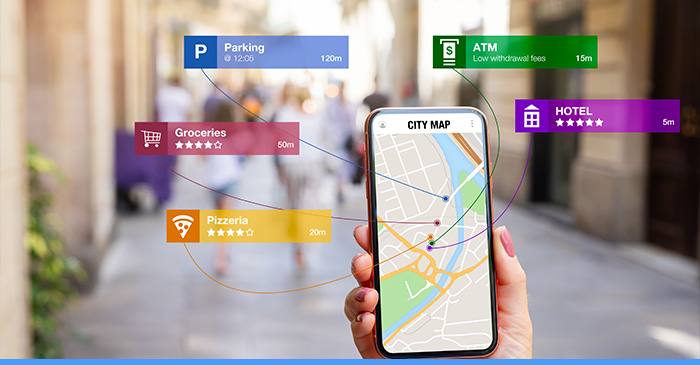
These days, location-based apps are very popular. Numerous smartphone apps have built-in geolocation features. But the question arises, how can you build a location-based app, and how can it help your company? The location-based smartphone apps are not simply for those looking for places, people, or directions.
Retailers are already sending notifications to individuals when they are close using technology like geofencing. Users of social networking apps can add location tags to text, video, or image posts. Weather applications access the user’s location to give alerts about current weather conditions. Mobile apps that use location information have many applications. The procedures for developing location-based apps, important features, and ideas for 2023 will all be covered in this blog.
What Are Location-based Apps?
Location-based apps are mobile applications that use location data to provide users with relevant information or services based on their geographic location. These apps use a smartphone’s GPS or other location technologies to determine the user’s location and provide relevant content or features. Examples of location-based services apps include:
Mapping and Navigation Apps: These apps provide turn-by-turn directions to a user’s desired destination, including driving, walking, or public transportation routes.
Local Discovery Apps: These apps help users discover nearby attractions, restaurants, or events based on location. Examples include Yelp, Foursquare, and TripAdvisor.
Weather Apps: These apps provide users with up-to-date weather information for their current location and other locations they may be interested in.
Fitness Apps: Some fitness apps use location data to track a user’s outdoor workouts, such as running or cycling, and provide insights into their performance.
Social Networking Apps: Some social networking apps, such as Facebook and Instagram, use location data to allow users to check in to locations or share their current location with friends.
How to Create Location-based Apps?
Creating a location-based app involves building a software application that uses the GPS data of a user’s device to provide location-specific information or services. Here are the basic steps you would need to follow:
Define the purpose and features of the app: The first step in creating a location-based app is to define its purpose and features. Ask yourself what problem you are trying to solve or what need your app will fulfill. Then, determine what features will be required to fulfill that purpose. For example, a location-based app might allow users to find nearby restaurants, track a delivery, or locate a lost item.
Choose a development platform: Once you have defined the purpose and features of your app, you need to choose a development platform capable of handling location data. Some popular platforms for building location-based apps include iOS, Android, and web-based frameworks such as React Native.
Integrate a location API: Your app must interact with location data to deliver the desired functionality. Integrating a location API (Application Programming Interface) into your app requires. Several APIs are available, including Google Maps API, Mapbox, and OpenStreetMap.
Design the user interface: Once you have integrated the location API, it’s time to design your app’s user interface. This will involve designing screens displaying relevant information to users based on location, such as nearby restaurants or stores.
Test and deploy: Before launching your app, it’s essential to thoroughly test it to ensure that it functions correctly and meets user needs. Once you have tested and resolved any issues, you can deploy your app to the App Store or Google Play.
Maintain and update: Once your app is live, it’s important to maintain and update it regularly to keep up with changing technologies and user needs. This may involve adding new features or improving existing ones.
What Are the Types of Location-based Apps?

Depending on their intended purpose and functionality, many location-based apps exist. Here are some common types of location-based apps:
Navigation Apps: Navigation apps use location data to provide users with directions, traffic updates, and real-time mapping. Examples of popular navigation apps include Google Maps, Waze, and Apple Maps.
Geotagging Apps: Geotagging apps allow users to add location data to their photos, videos, and social media posts. Examples of popular geotagging apps include Instagram, Snapchat, and Facebook.
Location-based Gaming Apps: Location-based gaming apps use GPS data to create interactive games played in the real world. Examples of popular location-based gaming apps include Pokémon Go and Ingress.
Travel and Tourism Apps: Travel and tourism apps use location data to inform users about nearby tourist attractions, hotels, and restaurants. Examples of popular travel and tourism apps include TripAdvisor, Yelp, and Airbnb.
Health and Fitness Apps: Health and fitness apps use location data to track users’ workouts, distance traveled, and other fitness-related metrics. Examples of popular health and fitness apps include Nike+ Run Club, Strava, and MyFitnessPal.
On-demand Services Apps: On-demand services apps use location data to connect users with nearby service providers such as food delivery, ride-hailing, and home services. Examples of popular on-demand service apps include Uber, Postmates, and TaskRabbit.
Benefits of Location-based App Features

Location-based app features can provide many benefits for both users and businesses. The main benefits of location-based apps are:
Personalization: Location-based apps can use a user’s location data to provide personalized recommendations and offers based on their current location. For example, a restaurant app might send a user a coupon for a nearby restaurant when they are in the area.
Improved User Experience: Location-based apps can provide a more seamless and convenient user experience. They provide relevant information and services based on a user’s location. For example, a transportation app might show users the closest available ride options when they open it.
See more: Learn How to Create a Food Delivery App: Tips and Strategies
Increased Engagement: Location-based apps can increase user engagement by offering unique features and functionality. When a user is in a specific location, it can be made available. For example, a museum app might offer a guided tour only when a user is inside the museum.
Enhanced Marketing: Location-based apps can be a powerful tool for businesses to reach and engage customers. For example, a retailer might send a push notification to users when they are in the vicinity of one of their stores. They may then offer a discount or promotion to encourage them to visit.
Real-time Insights: Location-based apps can provide businesses valuable real-time insights into customer behavior and preferences. For example, a retail store might use location data to track foot traffic and optimize store layout and product placement.
Conclusion
In conclusion, location-based app development has become integral to our daily lives and offers many benefits for users and businesses. By leveraging location data, businesses can create personalized and engaging customer experiences. It helps gain valuable insights into customer behavior and preferences. If you want to develop a location-based app for your business, consider partnering with Arturo Digital.
Read more: Outsource App Development for Cost-Effective Solutions